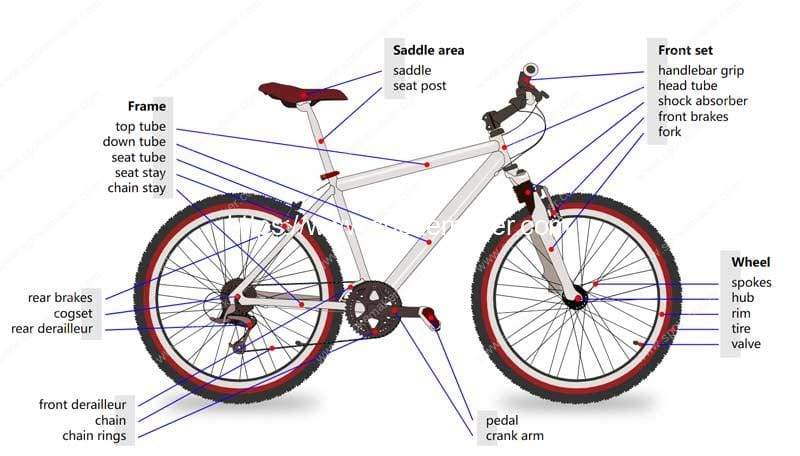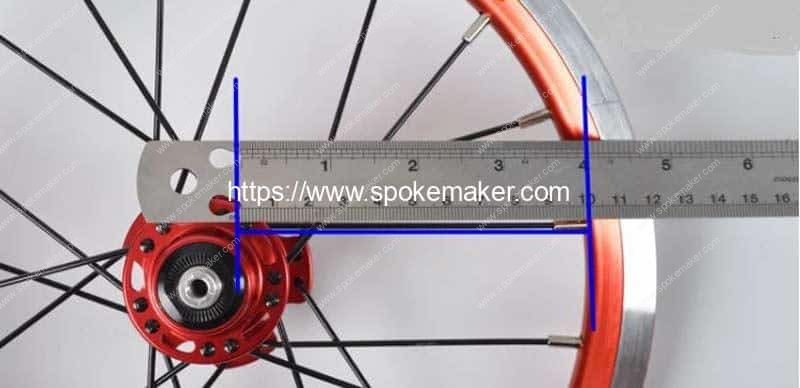Cycle Spoke Size Standard and How to Measure
Table of Contents
What is Wire Spoke
High quality bicycles with conventional wheels use spokes of stainless steel, while cheaper bicycles may use galvanized (also called “rustless”) or chrome plated spokes. While a good quality spoke is capable of supporting about 225 kgf (c. 500 pounds-force or 2,200 newtons) of tension, they are used at a fraction of this load to avoid suffering fatigue failures. Since bicycle and wheelchair wheel spokes are only in tension, flexible and strong materials such as synthetic fibers, are also occasionally used.[9] Metal spokes can also be ovalized or bladed to reduce aerodynamic drag, and butted (double or even triple) to reduce weight while maintaining strength.
A variation on the wire-spoked wheel was Tioga’s “Tension Disk”, which appeared superficially to be a solid disk but was in fact constructed using the same principles as a normal tension-spoked wheel. Instead of individual wire spokes, a continuous thread of Kevlar (aramid) was used to lace the hub to the rim under high tension. The threads were encased in a translucent disk for protection and some aerodynamic benefit, but this was not a structural component.
What is Spoke Nipple
A spoke nipple holds a bicycle wheel’s rim to each spoke.
The spoke nipple is a headed cylinder with threading on the inside through part of its length (there is an unthreaded lead-in nearest the “flats”). Traditionally, the nipples fit in holes in the rim, so that the head of the nipple is on the outermost part of the rim, while the other end of the nipple points inwards towards the hub. Many different types of nipples are now available, including internal nipples that sit entirely within the rim and can only be adjusted by removing the tire, as well as externally threaded nipples that thread into the rim (such as those used by Mavic Ksyriums). The threading grasps the spoke, so turning it increases or decreases tension in the spoke and influences the position of the hub relative to the rim.
Thread pitch can vary with thread size, but is 0.454mm for common spoke thicknesses, which use thread types Fg 2, Fg 2.3 or Fg 2.6.[1] Since spoke threading and nipple threading must match, boxes of spokes usually include a like number of nipples. Weight savings or the need for great strength due to building a wheel with few spokes might call for obtaining different nipples from those shipped with the spokes. Standard materials for nipples are brass (usually nickel-plated) and aluminum. Brass is heavier but more durable and less prone to corrosion, rounding of flats while tightening, breaking and galling; aluminum is far lighter. If using aluminum nipples, the spokes should be long enough to engage the full length of spoke nipple threads so that the load is carried from spoke to the top of the nipple.[2] If the spoke is only part way into the nipple, the nipple carries the tension load and is prone to breaking from fatigue failure. Also, with aluminum nipples care and a good spoke wrench are needed to avoid rounding the flats while tightening. Recently, titanium nipples have become available from both US and Chinese sources. Proponents of titanium nipples[who?] suggest that they combine the advantages of brass and aluminum nipples (strength and weight, respectively), while being more corrosion resistant than either material.
What does 8G 9G 10G 12G 14G 15G mean
The 8G 9G 10G 13G 14G 15G of bicycle spokes means the model of the spoke. The model is roughly subdivided into different G standard according to the diameter. 14G spokes represent the spokes with a diameter of 1.95mm, which is also called the 14th spoke. It is the most commonly used one.
| Wire Gauge | Diameter |
| 15G | 1.8mm |
| 14G | 2.0mm |
| 13G | 2.3mm |
| 12G | 2.6mm |
| 11G | 2.9mm |
| 10G | 3.2mm |
| 9G | 3.5mm |
| 8G | 4mm |
| 7G | 4.5mm |
How to measure wire spoke length
It is not the size of the bicycle that determines the length of the spokes of a bicycle, but: the width of the rim, the weaving of the spokes, the height of the hub, and the offset length are all factors that affect the length of the spokes. So how long is it to buy? How to measure? The national standard for measuring the length of the spokes: start from the inside of the elbow to the other end (see Figure 1 below). It can be removed for measurement. If it is not convenient to remove it, you can use a tape measure to measure on the original car(see Figure 1 below). Measuring method: The hub hole starts to measure along the spokes to the inside of the rim, and you can basically use it by adding 1-2MM. You can measure a few more to reduce the error!
Spoke length measurement is industry standard from elbow inside bent to end of threaded. The spoke length plus or minus tolerance is about 1MM
Company Profile
Romiter Group is a market leading designer and a manufacturer of bicycle spokes and motorcycle spokes making machine, which wins wide reputation for products with high efficiency, excellent reliability, easy maintenance and long lifespan.
We provides a complete bicycle and motorcycle spokes and nipple making solution, which includes Bicycle Spokes Making Machine, Bicycle Spokes Nipple Making Machine, High Speed Motorcycle Spokes Making Machine, Motorcycle Spokes Nipple Making Machine, Butted Spokes Making Machine, Bladed Spokes Making Machine, Wire Straightening Cutting Machine Machine, Wire Rivet Making Machine, Cycle Spoke Nipples Packing Machine, Cycle Rim Making Machine , Aluminium Wheel Rim Production Line etc.





